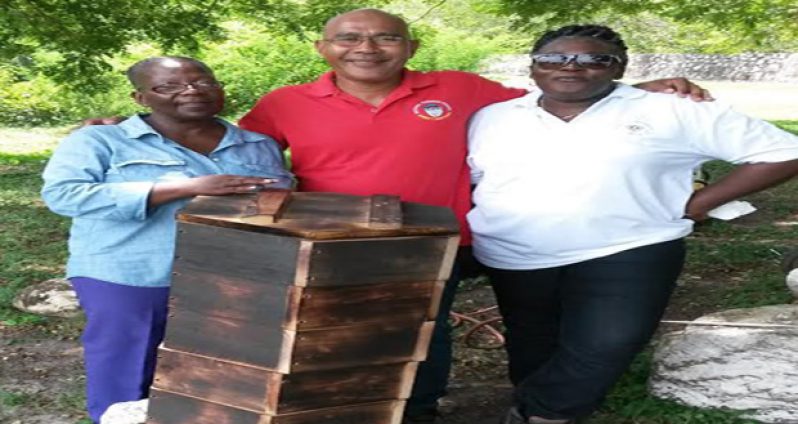LOCAL beekeepers who are members of the Guyana Apicultural Society (GAS) have said that a bee-keeping training programme organised for them by the Inter American Institute for Cooperation in Agriculture (IICA) last week had been a true eye-opener.Veteran bee-keeper Janice Fraser said, “I have been into bee-keeping for the past 25 years and this is the first time ever that I have heard of these “divine geometry” techniques; it is the first time ever that I have seen this type of hive (Perone hive). It has been really amazing for me, adoption of these techniques will result in very great benefits of production and profitability for our bee-keepers.”
Joel Fredericks, Toshao of the Mainstay/Whyaka community, and an avid bee-keeper said, “The new Perone hives, which we learnt about, for the first time ever, which we saw for the first time ever, makes a great deal of sense. I learnt things that I never knew of before and I am going back to my community with renewed energy for bee-keeping since I now know what to do; how to get the results I want..”
Another participant, Carlotta De Jesus, had similar sentiments.
Mrs De Jesus was particularly excited at the possibility of being able to produce Mead, a drink made from honey, as value-added to bee-keeping.
The three bee-keepers made these remarks at the end of a three-day programme of support for beekeepers by the local office of the IICA last week.
The kudos were given to the main resource person, Dr Manuel David Sanchez Hermosilo, bee-keeper from Mexico, who also works as the IICA country representative in the Dominican Republic.
The expert had given them information on permapiculture, a new and proven way of bee-keeping which stresses minimal interference by humans in the honey production process.
Dr Sanchez had stressed, “Bees have been doing what they do for millions of years. Just get them into the hive, then leave them alone. Let them do what they know to do. ”
The Perone hive, which he trained them to build and use, was designed with the proportions of a “divine geometry” and imitated the holes in large trees where wild bee colonies are fond of occupying and producing honey.
The Perone hives additionally are placed at the right spots in relation to electromagnetic lines which criss-cross the earth.
Carlotta De Jesus said, “Well that dowser and electromagnetic lines and crossings were completely new to me. I had to see it to believe it. It showed me a new dimension to bee-keeping.”
Fredericks commended the idea of harvesting honey at nights using a red light so that bees, which cannot detect red lights, can remain undisturbed during the removal of honeycombs.
“The IICA programme was very good. We got brand new ideas about beekeeping,” Janice Fraser said.
The IICA programme was held at the Mangrove Benab at Cove and John, East Coast Demerara from Monday to Wednesday last week.
Mr Wilmot Garnett of the local office of the IICA said the agency will follow-up with additional training and help to bee-keepers in the coming months.
By Clifford Stanley




.png)









